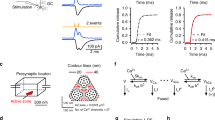Abstract
In the neuromuscular junction, blockade of potassium channels can produce multiple discharges after single nerve stimulation. Multielectrode recording from the nerve trunk and myelinated and non-myelinated parts of the nerve ending demonstrated that repetitive presynaptic spikes elicited by 4-aminopyridine arise earliest within the part of the axon proximal to the motor nerve ending.
Similar content being viewed by others
REFERENCES
J. Molgo, M. Lemeignan, and P. Lechat, “Changes in transmitter release at frog neuromuscular junction induced by 4-aminopyridine,” C. R. Acad. Sci., Ser. D, 281,No. 21, 1637–169 (1975).
R. A. Giniatullin, “Repetitive firing in motor nerve endings: modulation by divalent cations, rhythmic activation, and cholinergic agents,” Neirofiziologiya, 24,No. 4, 387–395 (1992).
Author information
Authors and Affiliations
Corresponding author
Rights and permissions
About this article
Cite this article
Samigullin, D.V., Afzalov, R.A., Giniatullin, R.A. et al. Localization of the Repetitive Firing Generation Site Induced by 4-Aminopyridine at the Frog Neuromuscular Junction. Neurophysiology 34, 222 (2002). https://doi.org/10.1023/A:1020728022339
Issue Date:
DOI: https://doi.org/10.1023/A:1020728022339




